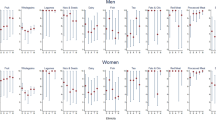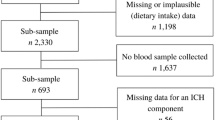Abstract
BACKGROUNG/OBJECTIVES:
A higher educational level is associated with a healthier diet. The goal of this study was to establish whether this association is mediated by attitudes toward healthy eating.
SUBJECTS/METHODS:
The cross-sectional MONA LISA-NUT study was performed in 2005–2007 on adults aged 35–64 years from northern and north-eastern France. Diet quality was assessed on the basis of a 3-day food record and a validated score based on French national dietary guidelines. Specific questions investigated attitudes toward healthy eating. Multivariate analyses were used to quantify the proportion of the educational level–diet relationship that was mediated by attitudes toward healthy eating.
RESULTS:
Among the 1631 subjects, favourable attitudes toward healthy eating were associated with both higher educational level and diet quality. In the mediation analysis, ‘organic food consumption’ explained 14% (95% confidence interval (8;24)) of the educational level–diet relationship and ‘attention paid to health when buying food’ explained 9% (3;16). In contrast, ‘attention to food choice’, ‘searching for information about food’ and ‘perceived role of eating’ were not mediators of the association between educational level and diet. In a multivariate model, the attitude items together accounted for 25% (10;45) of the relationship. The mediation was more pronounced in women than in men (37% (15;54) vs 16% (1;27), respectively) and was significant for consumption of fruits and vegetables (23% (13;37)), whole-grain food (32% (15;58)) and seafood (22% (9;55)).
CONCLUSIONS:
Our results suggest that poor attitudes toward healthy eating in groups with low socioeconomic status constitute an additional factor (along with cost constraints) in the choice of unhealthy foods.
This is a preview of subscription content, access via your institution
Access options
Subscribe to this journal
Receive 12 print issues and online access
$259.00 per year
only $21.58 per issue
Buy this article
- Purchase on Springer Link
- Instant access to full article PDF
Prices may be subject to local taxes which are calculated during checkout
Similar content being viewed by others
References
World Health Organization/Food and Agriculture Organization. Diet, Nutrition and the Prevention of Chronic Diseases. Report of a Joint WHO/FAO Expert Consultation. World Health Organization: Geneva, Switzerland, 2003.
Estaquio C, Kesse-Guyot E, Deschamps V, Bertrais S, Dauchet L, Galan P et al. Adherence to the French Programme National Nutrition Santé Guideline Score is associated with better nutrient intake and nutritional status. J Am Diet Assoc 2009; 109: 1031–1041.
Darmon N, Drewnowski A . Does social class predict diet quality? Am J Clin Nutr 2008; 87: 1107–1117.
Wyndels K, Dallongeville J, Simon C, Bongard V, Wagner A, Ruidavets J-B et al. Regional factors interact with educational and income tax levels to influence food intake in France. Eur J Clin Nutr 2011; 65: 1067–1075.
Braveman PA, Cubbin C, Egerter S, Chideya S, Marchi KS, Metzler M et al. Socioeconomic status in health research: one size does not fit all. JAMA 2005; 294: 2879–2888.
Aggarwal A, Monsivais P, Cook AJ, Drewnowski A . Does diet cost mediate the relation between socioeconomic position and diet quality? Eur J Clin Nutr 2011; 65: 1059–1066.
Diez-Roux AV, Nieto FJ, Caulfield L, Tyroler HA, Watson RL, Szklo M . Neighbourhood differences in diet: the Atherosclerosis Risk in Communities (ARIC) Study. J Epidemiol Community Health 1999; 53: 55–63.
Morland K, Wing S, Roux AD . The contextual effect of the local food environment on residents’ diets: the Atherosclerosis Risk in Communities Study. Am J Public Health 2002; 92: 1761–1768.
Turrell G, Hewitt B, Patterson C, Oldenburg B . Measuring socio-economic position in dietary research: Is choice of socio-economic indicator important? Public Health Nutr 2003; 6: 191–200.
Wardle J, Steptoe A . Socioeconomic differences in attitudes and beliefs about healthy lifestyles. J Epidemiol Community Health 2003; 57: 440–443.
Turrell G, Kavanagh AM . Socio-economic pathways to diet: modelling the association between socio-economic position and food purchasing behaviour. Public Health Nutr 2006; 9: 375–383.
Ball K, Crawford D, Mishra G . Socio-economic inequalities in women’s fruit and vegetable intakes: a multilevel study of individual, social and environmental mediators. Public Health Nutr 2006; 9: 623–630.
Cullen KW, Lara KM, de Moor C . Familial concordance of dietary fat practices and intake. Fam Community Health 2002; 25: 65–75.
Groth MV, Fagt S, Brøndsted L . Social determinants of dietary habits in Denmark. Eur J Clin Nutr 2001; 55: 959–966.
Irala-Estévez JD, Groth M, Johansson L, Oltersdorf U, Prättälä R, Martínez-González MA . A systematic review of socio-economic differences in food habits in Europe: consumption of fruit and vegetables. Eur J Clin Nutr 2000; 54: 706–714.
Roos E, Prättälä R, Lahelma E, Kleemola P, Pietinen P . Modern and healthy?: socioeconomic differences in the quality of diet. Eur J Clin Nutr 1996; 50: 753–760.
Dallongeville J, Marécaux N, Cottel D, Bingham A, Amouyel P . Association between nutrition knowledge and nutritional intake in middle-aged men from Northern France. Public Health Nutr 2001; 4: 27–33.
Kraus SJ . Attitudes and the prediction of behavior: a meta-analysis of the empirical literature. Pers Soc Psychol Bull 1995; 21: 58–75.
Hupkens CLH, Knibbe RA, Drop MJ . Social class differences in food consumption: the explanatory value of permissiveness and health and cost considerations. Eur J Public Health 2005; 10: 108–113.
Traill WB, Chambers SA, Butler L . Attitudinal and demographic determinants of diet quality and implications for policy targeting. J Hum Nutr Diet 2012; 25: 87–94.
Wardle J, Haase AM, Steptoe A, Nillapun M, Jonwutiwes K, Bellisle F . Gender differences in food choice: the contribution of health beliefs and dieting. Ann Behav Med 2004; 27: 107–116.
Ferrières J, Bongard V, Dallongeville J, Arveiler D, Cottel D, Haas B et al. Trends in plasma lipids, lipoproteins and dyslipidaemias in French adults, 1996–2007. Arch Cardiovasc Dis 2009; 102: 293–301.
Wagner A, Sadoun A, Dallongeville J, Ferrières J, Amouyel P, Ruidavets J-B et al. High blood pressure prevalence and control in a middle-aged French population and their associated factors: the MONA LISA study. J. Hypertens 2011; 29: 43–50.
Willett W . Nutritional Epidemiology. Oxford University Press: Oxford, UK, 2012.
Cade J, Thompson R, Burley V, Warm D . Development, validation and utilisation of food-frequency questionnaires — a review. Public Health Nutr 2002; 5: 567–587.
CIQUAL AFSSA/ANSES. French Food Composition Table. 2008: http://www.anses.fr/TableCIQUAL/ (Accessed in November 2010).
Black AE, Coward WA, Cole TJ, Prentice AM . Human energy expenditure in affluent societies: an analysis of 574 doubly-labelled water measurements. Eur J Clin Nutr 1996; 50: 72–92.
Pereira MA, FitzerGerald SJ, Gregg EW, Joswiak ML, Ryan WJ, Suminski RR et al. A collection of Physical Activity Questionnaires for health-related research. Med Sci Sports Exerc 1997; 29: S1–205.
Roeykens J, Rogers R, Meeusen R, Magnus L, Borms J, de Meirleir K . Validity and reliability in a Flemish population of the WHO–MONICA Optional Study of Physical Activity Questionnaire. Med Sci Sports Exerc 1998; 30: 1071–1075.
Ainsworth BE, Haskell WL, Leon AS, Jacobs DR Jr, Montoye HJ, Sallis JF et al. Compendium of physical activities: classification of energy costs of human physical activities. Med Sci Sports Exerc 1993; 25: 71–80.
Baron RM, Kenny DA . The moderator–mediator variable distinction in social psychological research: conceptual, strategic, and statistical considerations. J Pers Soc Psychol 1986; 51: 1173–1182.
Insee, Définitions et méthodes, PCS 2003, Niveau 1, Liste des catégories socioprofessionnelles agrégées. http://www.insee.fr/fr/methodes/default.asp?page=nomenclatures/pcs2003/liste_n1.htm (Accessed in May 2012).
R Development Core Team. R: A Language and Environment for Statistical Computing. R Foundation for Statistical Computing: Vienna, Austria, 2010.
Canty A, Ripley BD . Boot: Bootstrap R (S-Plus) Functions 2013.
Davison AC, Hinkley DV . Bootstrap Methods and Their Applications. Cambridge University Press: Cambridge, UK, 1997.
Darmon N, Ferguson EL, Briend A . A cost constraint alone has adverse effects on food selection and nutrient density: an analysis of human diets by linear programming. J Nutr 2002; 132: 3764–3771.
Drewnowski A, Darmon N . Food choices and diet costs: an economic analysis. J Nutr 2005; 135: 900–904.
Beydoun MA, Wang Y . How do socio-economic status, perceived economic barriers and nutritional benefits affect quality of dietary intake among US adults? Eur J Clin Nutr 2007; 62: 303–313.
Zanoli R, Naspetti S . Consumer motivations in the purchase of organic food: a means-end approach. Br Food J 2002; 104: 643–653.
Bourdieu P . Distinction: A Social Critique of the Judgement of Taste. Harvard University Press: Cambridge, MA, USA, 1984.
Barker M, Lawrence WT, Skinner TC, Haslam CO, Robinson SM, Inskip HM et al. Constraints on food choices of women in the UK with lower educational attainment. Public Health Nutr 2008; 11: 1229–1237.
Miura K, Giskes K, Turrell G . Contribution of take-out food consumption to socioeconomic differences in fruit and vegetable intake: a mediation analysis. J Am Diet Assoc 2011; 111: 1556–1562.
Acknowledgements
We thank the nurses, physicians, dieticians, computer scientists and secretarial staff variously in Lille, Strasbourg, Toulouse, the Centre de Médecine Préventive de Lille, the Laboratoire d’Analyses Génomiques, the Service de Biologie Spécialisée de l’Institut Pasteur de Lille, the Centre de Santé de la MGEN de Strasbourg, the Unité de Coordination de la Biologie des Essais Cliniques des Hôpitaux Universitaires de Strasbourg, the Department of Cardiology of the Toulouse University Hospital and the participating city councils in the three regions. The third MONA LISA survey was made possible by an unrestricted grant from Pfizer and a grant from the French National Research Agency (ANR-05-PNRA-018).
Author information
Authors and Affiliations
Corresponding author
Ethics declarations
Competing interests
The authors declare no conflict of interest.
Additional information
Supplementary Information accompanies this paper on the European Journal of Clinical Nutrition website
Supplementary information
Rights and permissions
About this article
Cite this article
Lê, J., Dallongeville, J., Wagner, A. et al. Attitudes toward healthy eating: a mediator of the educational level–diet relationship. Eur J Clin Nutr 67, 808–814 (2013). https://doi.org/10.1038/ejcn.2013.110
Received:
Revised:
Accepted:
Published:
Issue Date:
DOI: https://doi.org/10.1038/ejcn.2013.110
Keywords
This article is cited by
-
Socioeconomic inequalities in self-assessed health and food consumption: the mediating roles of daily hassles and the perceived importance of health
BMC Public Health (2023)
-
Rebalancing meat and legume consumption: change-inducing food choice motives and associated individual characteristics in non-vegetarian adults
International Journal of Behavioral Nutrition and Physical Activity (2022)
-
An examination of the socio-demographic correlates of patient adherence to self-management behaviors and the mediating roles of health attitudes and self-efficacy among patients with coexisting type 2 diabetes and hypertension
BMC Public Health (2020)
-
Association between diet-related knowledge, attitudes, behaviors, and self-rated health in Chinese adult residents: a population-based study
BMC Public Health (2020)
-
Food choice motives including sustainability during purchasing are associated with a healthy dietary pattern in French adults
Nutrition Journal (2017)



